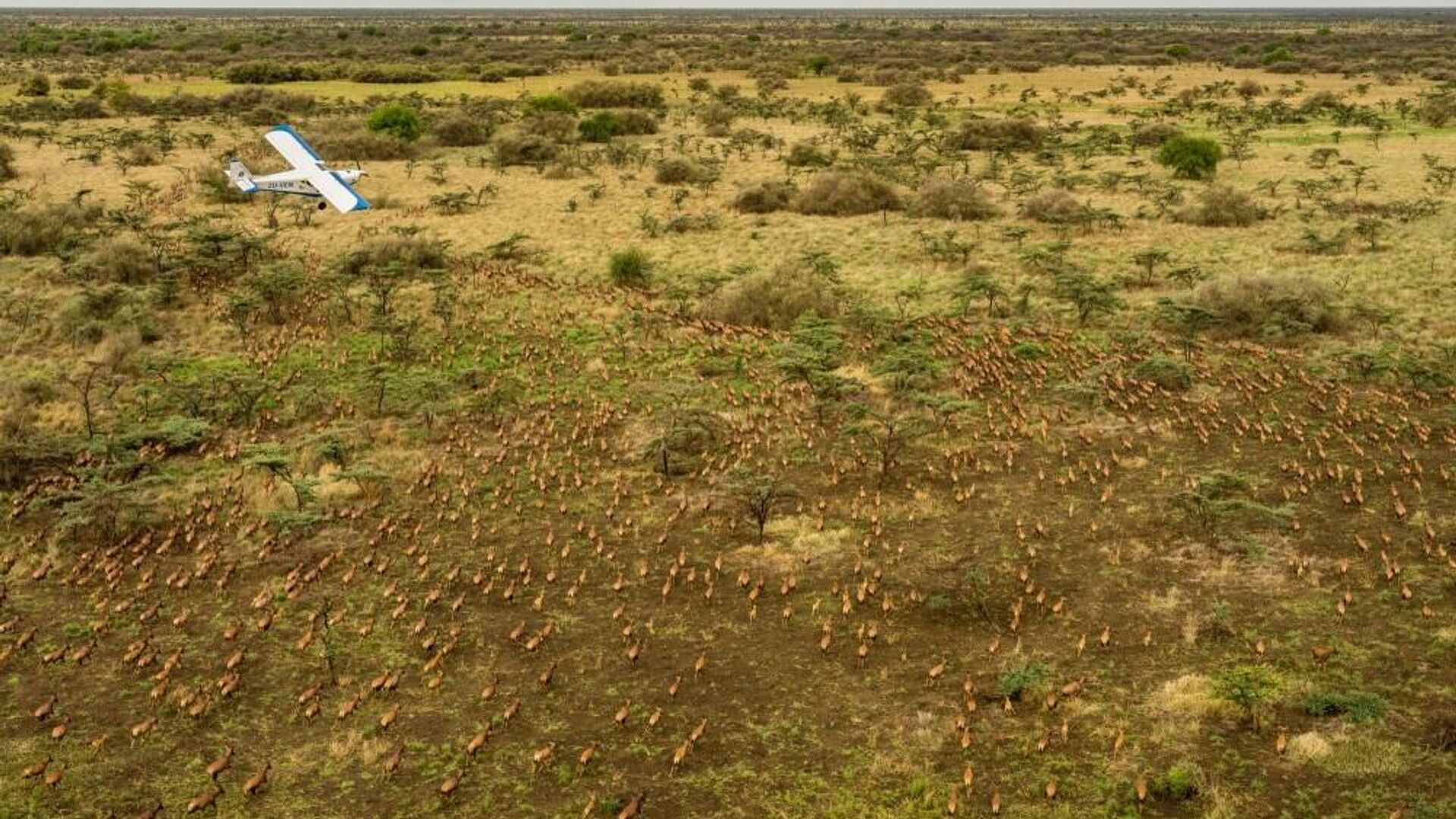https://en.sputniknews.africa/20240626/worlds-largest-land-animal-migration-of-six-mln-antelope-uncovered-by-aerial-study-in-south-sudan-1067238796.html
World's Largest Land Animal Migration of Six Mln Antelope Uncovered by Aerial Study in South Sudan
World's Largest Land Animal Migration of Six Mln Antelope Uncovered by Aerial Study in South Sudan
Sputnik Africa
By comparison, the famous annual “Great Migration” of gazelles, zebras, and wildebeests, which travels from the plains of Tanzania's Serengeti National Park to... 26.06.2024, Sputnik Africa
2024-06-26T16:44+0200
2024-06-26T16:44+0200
2024-06-26T17:24+0200
south sudan
tanzania
kenya
animals
sub-saharan africa
east africa
tourism
wildlife
salva kiir
ethiopia
https://cdn1.img.sputniknews.africa/img/07e8/06/1a/1067241388_0:52:1001:615_1920x0_80_0_0_fa3df37840fb518d6e7536bc98753d5f.jpg
The largest land animal migration on the planet, comprising 6 million antelopes, was uncovered by a comprehensive aerial study in South Sudan.The phenomenon, known as the Great Nile Migration, is a magnificent natural event. The aerial survey of the Boma Badingilo Jonglei Landscape (BBJL) is part of an ongoing collaboration between South Sudan's government and the non-governmental organization (NGO) African Parks to preserve the area for future generations.Systematic assessment of wildlife, livestock, and human activities revealed that millions of white-eared kob antelopes, Mongalla gazelle, tiang antelopes, and reedbuck antelope migrate through the BBJL each year. Gambella National Park in Ethiopia plays a vital role in this ecosystem.It is important to note that wildlife diversity is important not only in an environmental context but also in a social one.The NGO head added that the survey demonstrated the dedication and "invaluable support" from the Government of South Sudan, the Ministry of Wildlife and Tourism, The Wilderness Project, and the NGO's dedicated donors.The survey covered an area of 122,774 km2, including the entire range of the four main antelope species of the Great Nile Migration. Two aircraft were equipped with cameras that were configured to capture a photograph every two seconds. This generated 330,000 images, which were analyzed by graduate students at the University of Juba using animal counting software. The survey also used data from 251 tracking collars on large mammals, providing a complete picture of the ecology of the region, which stretches from South Sudan to Ethiopia.
south sudan
tanzania
kenya
east africa
ethiopia
Sputnik Africa
feedback@sputniknews.com
+74956456601
MIA „Rossiya Segodnya“
2024
Christina Glazkova
https://cdn1.img.sputniknews.africa/img/07e7/0b/07/1063380906_0:0:673:674_100x100_80_0_0_79628b4d0cd9f29291a57aa13bbf9e7a.jpg
Christina Glazkova
https://cdn1.img.sputniknews.africa/img/07e7/0b/07/1063380906_0:0:673:674_100x100_80_0_0_79628b4d0cd9f29291a57aa13bbf9e7a.jpg
News
en_EN
Sputnik Africa
feedback@sputniknews.com
+74956456601
MIA „Rossiya Segodnya“
Sputnik Africa
feedback@sputniknews.com
+74956456601
MIA „Rossiya Segodnya“
Christina Glazkova
https://cdn1.img.sputniknews.africa/img/07e7/0b/07/1063380906_0:0:673:674_100x100_80_0_0_79628b4d0cd9f29291a57aa13bbf9e7a.jpg
south sudan, tanzania, kenya, animals, east africa, tourism, wildlife, salva kiir, ethiopia, government, environment
south sudan, tanzania, kenya, animals, east africa, tourism, wildlife, salva kiir, ethiopia, government, environment
World's Largest Land Animal Migration of Six Mln Antelope Uncovered by Aerial Study in South Sudan
16:44 26.06.2024 (Updated: 17:24 26.06.2024) Christina Glazkova
Writer / Editor
By comparison, the famous annual “Great Migration” of gazelles, zebras, and wildebeests, which travels from the plains of Tanzania's Serengeti National Park to Kenya's Maasai Mara National Reserve, involves a total of about 2 million animals.
The largest land animal migration on the planet, comprising 6 million antelopes, was
uncovered by a comprehensive aerial study in South Sudan.
The phenomenon, known as the Great Nile Migration, is a magnificent natural event. The aerial survey of the Boma Badingilo Jonglei Landscape (BBJL) is part of an ongoing collaboration between
South Sudan's government and the non-governmental organization (NGO) African Parks to preserve the area for future generations.
Systematic assessment of
wildlife, livestock, and human activities revealed that millions of white-eared kob antelopes, Mongalla gazelle, tiang antelopes, and reedbuck antelope migrate through the BBJL each year. Gambella National Park in
Ethiopia plays a vital role in this ecosystem.
“As South Sudan continues to develop, we are committed to transforming the wildlife sector into a sustainable tourism industry. To activate this, I call upon the security forces, particularly the Ministry of Wildlife and its partners, to prioritize the training and equipping of wildlife rangers to combat poaching and trafficking of illegal wildlife products in protected areas,” President of South Sudan Salva Kiir was quoted as saying by the NGO.
It is important to note that wildlife diversity is important not only in an environmental context but also in a social one.
“The results of this survey are nothing short of staggering. The astonishing scale of the migration is only equalled by the responsibility to ensure that it survives into the future in an extremely complex landscape. This wildlife and larger ecosystem are the basis for survival for multiple ethnic groupings, which are often in conflict with each other over resources. Successful management of this landscape will only be possible through building trust with and amongst these ethnic groupings,” the African Parks cited its CEO, Peter Fearnhead.
The NGO head added that the survey demonstrated the
dedication and "invaluable support" from the Government of South Sudan, the Ministry of Wildlife and
Tourism, The Wilderness Project, and the NGO's dedicated donors.
The survey covered an area of 122,774 km2, including the entire range of the four main antelope species of the Great Nile Migration. Two aircraft were equipped with cameras that were configured to capture a photograph every two seconds. This generated 330,000 images, which were analyzed by graduate students at the University of Juba using
animal counting software. The survey also used data from 251 tracking collars on large mammals, providing a complete picture of the ecology of the region, which stretches from South Sudan to Ethiopia.


